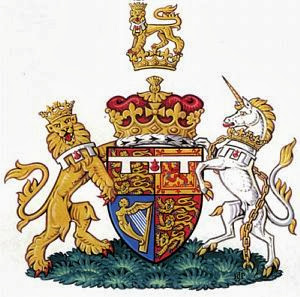 |
| Conjugal Arms of TRH The Duke & Duchess of Cambridge (C) The College of Arms |
Although not seen very often, Conjugal Arms are firmly rooted in royal tradition and have been used by HM The Queen & HRH The Duke of Edinburgh as well as by TRH The Prince of Wales & The Duchess of Cornwall. Conjugal Arms are traditionally seen on occasions when both husband and wife are performing or are present at official ceremonies or events. In such circumstances, one may expect to see the Conjugal Arms displayed on ceremonial plaques, memorials etc.
As would be expected, the Conjugal Arms have been designed by the College of Arms. Over time, as the Duke of Cambridge's status evolves, so too will his own coat of arms and, by automatic extension, the Conjugal Arms.
The Conjugal Arms of The Duke and Duchess of Cambridge displays the shield of The Duke of Cambridge on the left (heraldically dexter) and that of The Duchess on the right (heraldically sinister). The shields are flanked by the Duke of Cambridge's Royal Supporters, the Lion supporting The Duke's shield and the Unicorn supporting The Duchess's.
 |
| Armorial Bearings of HRH The Duke of Cambridge KG KT (in this image the shield is not encircled by the Order of the Garter) |
The Duke's shield (as depicted in the Conjugal Arms) is encircled by the Order of the Garter, the United Kingdom's oldest Order of Chivalry. In 2008 HRH became the Order's one-thousandth knight.
 |
| Armorial Bearings of HRH The Duchess of Cambridge (C) The College of Arms |
 |
| Armorial Bearings of HRH The Duchess of Cambridge originally borne by HRH following the 2011 grant of arms to her father, Mr. Michael Middleton (C) The College of Arms |
The Duchess's shield (as depicted in the Conjugal Arms) is encircled by a wreath of oak -- this is simply to provide artistic balance to the Order of the Garter that encircles the Duke's shield. The wreath will eventually be replaced upon the Duchess's appointment to an order (the first order is likely to be the Royal Victorian Order).
.jpg)
.jpg)
.jpg)
.jpg)
.jpg)



.jpg)
.jpg)









